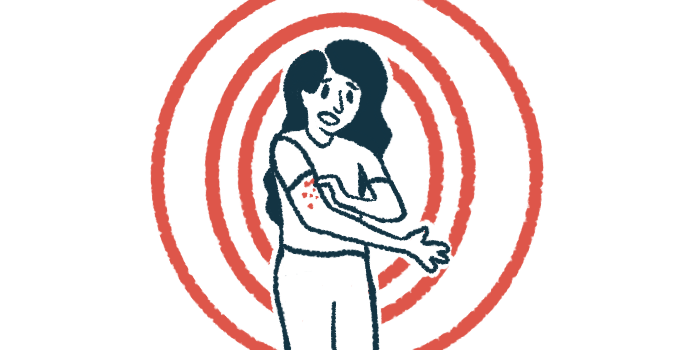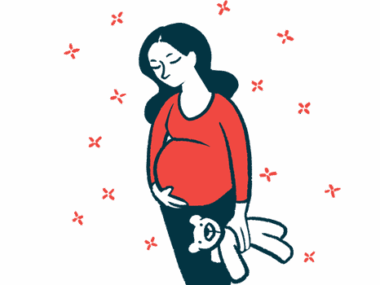Livmarli eases Alagille teen’s itch following liver transplant issues
Case study: Organ began to malfunction years after he received it from father
Written by |

Treatment with Livmarli (maralixibat) quickly and safely reduced severe itching in a 16-year-old boy with Alagille syndrome after his transplanted liver started to malfunction, a case study reports.
The therapy also reduced blood levels of bile acids, the main component of the digestive fluid bile that is transported from the liver to the intestines. High bile acids in the blood can indicate liver damage — including graft dysfunction, in which a transplanted organ’s function starts to decline — and are thought to contribute to severe itching, or pruritus.
“Although a single case study, the rapid and sustained improvements in pruritus and [blood bile acid] levels observed in this patient provide real-world evidence supporting the therapeutic potential of [Livmarli] in patients with ALGS [Alagille syndrome] experiencing early-stage chronic graft dysfunction after liver transplantation,” researchers wrote.
The study, “Treatment of Pruritus With Maralixibat in Early-Stage Chronic Graft Dysfunction of a Child With Alagille Syndrome,” was published in the journal Cureus by a trio of researchers in Germany.
Up to 40% of Alagille patients need liver transplant before reaching adulthood
Genetic mutations cause Alagille syndrome, a disease that can impact several systems and organs in the body, including the liver. People with Alagille typically have a shortage of tubes that transport bile, resulting in slowed or stalled bile flow, or cholestasis. This causes bile to build up in the liver and leak into the blood, leading to liver damage and symptoms like itching.
Up to 40% of Alagille patients need a liver transplant before reaching adulthood. Still, “up to 12% of [them]… will experience graft failure within five years,” the researchers wrote.
“Graft dysfunction may be classified as early stage based on the onset of pruritus, an increase in [blood bile acid] levels … and the presence of mild [spleen enlargement],” they added.
Mirum Pharmaceuticals’ Livmarli is an approved oral treatment for Alagille syndrome. It works by blocking an enzyme that carries bile acids from the intestine back to the blood and liver, increasing the amount of bile acids that are excreted in stool.
Data from clinical trials showed that this reduces itching and blood levels of bile acids, as well as the need for a liver transplant.
“However, there are limited data on the use of [Livmarli] for managing cholestatic pruritus in patients with ALGS who experience graft failure after a liver transplant,” the researchers wrote.
Livmarli eased signs of liver damage following issues with transplanted organ
In the present study, the trio described the case of 16-year-old boy in whom Livmarli treatment eased signs of liver damage after his transplanted liver started to lose function.
The boy was diagnosed with Alagille at the age of 2 months after showing cholestasis, mild pruritus, and evidence of progressive liver scarring, or fibrosis. Before he turned 3, he received a liver transplant from his father.
He was prescribed immunosuppressive treatment to avoid the risk of his body rejecting the transplant, vitamin D supplements for nutritional support, and ursodeoxycholic acid (UDCA, sold as Urso and Actigall) to help boost bile flow.
This prevented clinical complications up to the age of 15 years, when the boy showed a slightly enlarged spleen and worsening of liver damage markers. This suggested high blood pressure in the main vein that carries blood from the intestines and spleen to the liver, a sign of severe liver damage.
Despite the success of the transplant, the development of early-stage chronic graft dysfunction and worsening pruritus highlight the ongoing challenges faced by patients with ALGS, even after transplantation.
A year later, he developed early-stage chronic graft dysfunction, marked by severe pruritus that made him scratch himself until bloody, and high levels of bile acids in the blood.
“Despite the success of the transplant, the development of early-stage chronic graft dysfunction and worsening pruritus highlight the ongoing challenges faced by patients with ALGS, even after transplantation,” the researchers wrote.
To address the boy’s symptoms, clinicians prescribed him Livmarli. Two months after starting treatment, the boy’s pruritus resolved completely, and he had a clinically meaningful reduction in blood bile acid levels. After another two months, the boy “had dramatically improved quality of life,” the researchers wrote.
More than a year after beginning Livmarli treatment, the boy still had no pruritus.
“Overall, [Livmarli] was well tolerated, and no adverse events were reported,” the team wrote.
The positive response in this case indicates that this treatment strategy may be safe and effective in similar cases, according to the researchers. Still, “further research is warranted to determine the effectiveness of [Livmarli] in patients with ALGS who experience pruritus after liver transplant.”








